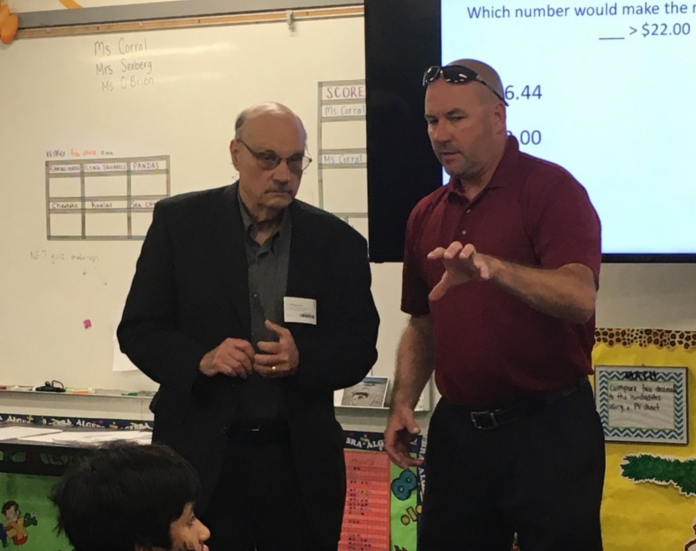
California’s top educator visited Gilroy classrooms for the first time in the history of the Gilroy Unified School District.
Michael W. Kirst, a two-time President of the California State Board of Education, long time adviser to Gov. Jerry Brown and retired Stanford University professor, toured the district’s public charter school, Gilroy Prep.
The K-7 charter has consistently been one of the highest scoring among all schools in state testing since two Gilroy educators founded the institution in 2011 with a charter approved by GUSD. It began as a K-2, adds a grade each year and has a long waiting list.
The visit was a boost for the school’s mission, said Kevin Sved, CEO of Navigator Schools, which operates GPS and Hollister Prep. Kirst toured HPS right after his March 27 GPS visit.
“It definitely reaffirms the great work we are doing…and it’s a reminder that we have practices that are worthy of sharing with other educators,” Sved said.
One reason for the invitation to Kirst was to demonstrate that charters and their approving districts can have excellent relations, Sven said.
He pointed to terrific support from GUSD, particularly in terms of facilities improvements.
“Not only does the State Board directly oversee numerous charter schools, they also set the bar for state standards,” Sven added.
“As both GPS and HPS consistently exceed those standards, this visit allowed us to show Dr. Kirst how our students continue to perform at such high levels.”
GUSD Superintendent Debbie Flores, school board President Patricia Midtgaard and VP Linda Piceno joined the 90-minute, morning tour.
“This is the first time a State Board of Education President has visited GUSD and we feel very honored that he took the time to visit GPS,” Flores later said.
“I was impressed with his knowledge of so many things, but particularly his understanding of best practices in the classroom,” she said.
“It was such a good visit and, obviously, good things are happening at that school,” said Midtgaard, a retired GUSD teacher and principal.
Of note, she added, were that a teacher and paraprofessional gave instruction in each classroom, meaning lower teacher/student ratios, and the use of technology, including iPads and large-screen monitors.
Piceno, a retired GUSD administrator, said, “Students were using (technology) in every classroom we visited. The teaching strategies included a lot of student interaction/discussion.”
Sharon Waller is Navigator’s Director of Student Services, a veteran GUSD special education teacher and a GPS founder.
“To have the State Board of Education President recognize our school and express positive feedback about our school model gives me hope that other schools in districts throughout California will come to study and learn about our excellent, inclusive educational model,” she said.
“I spoke to Dr. Kirst briefly about our model. He was impressed,” she added.
Kirst in an email declined to discuss his time in Gilroy.
“I do not comment on school visits. These are not evaluations, and are used to help my thinking about state policy,” he said.
When asked to reconsider, he responded, “I am sorry, but I cannot help you.”
Kirst was all talk, however, when interviewed last year for affluent readers of a weekly in Palo Alto and at Stanford, where the 80-year-old is Professor Emeritus of Education and Business Administration.
And in an article about the Harvard-educated board president “devising a radical transformation” of state schools, published last June by the online non-profit, CALmatters, Kirst said of his plan, “Even though this is my 52nd year in educational policy, I don’t know what’s going to happen.”
It was a reference to plans underway to rewire the power over classrooms by taking it from Sacramento politicians and bureaucrats and returning it local communities.
Kirst also is behind funding changes that hold districts more accountable for how they address the so-called achievement gap among student groups, including ethnic and socio-economic differences.
His approaches seem in line with what GPS founders envisioned whencharter schools were one way that reformers saw to amp up local power, wresting it even from school boards.
“We envisioned a school that provided all students with an excellent education, no matter their background, race, income or ability level,” Waller said.
“From our experience as educators in the traditional public schools we knew we could, should and had to do better for California students,” she said.
And the focus was and is on students “Most at-risk for academic failure, low socioeconomic students, and students who required extra support through special education.”
Co-founder Karen Humber was equally gratified to see the state’s top school official at GPS.
“I am very proud of the hard work and dedication of the Navigator teachers and support staff at both the Gilroy and Hollister campuses over the past six years,” the retired teacher said.
“Creating an innovative, rigorous and inclusive program that targets the needs of all students was our original vision, and we have succeeded in achieving that goal.
“I hope the positive results of Navigator’s program will be able to reach beyond the cities of Gilroy and Hollister.”












